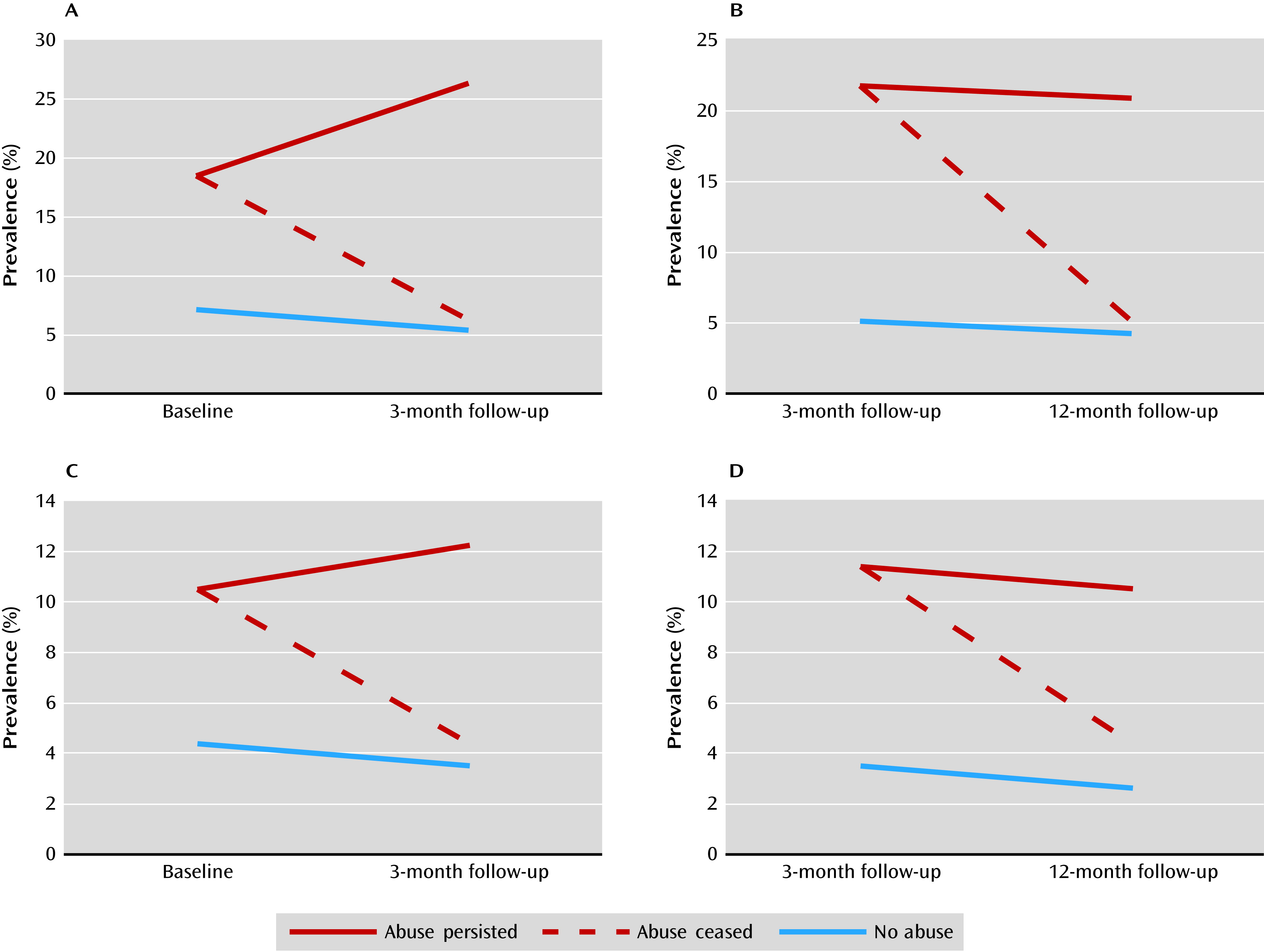Childhood Trauma and Psychosis in a Prospective Cohort Study: Cause, Effect, and Directionality
Abstract
Objective
Method
Results
Conclusions
Method
| Characteristic | N | % |
|---|---|---|
| Age (years) | ||
| 13 | 409 | 37 |
| 14 | 598 | 54 |
| 15 | 55 | 5 |
| 16 | 29 | 3 |
| Female | 496 | 45 |
| Country of birth | ||
| Born in Ireland | 907 | 82 |
| Mother born in Ireland | 857 | 79 |
| Father born in Ireland | 874 | 81 |
| Living with | ||
| Both parents | 914 | 83 |
| Mother only | 142 | 13 |
| Father only | 23 | 2 |
| Other | 17 | 2 |
Exposure and Outcome Measures
Statistical Analysis
Abuse as a predictor of psychotic experiences.
Cessation of abuse as a predictor of cessation of psychotic experiences.
Psychotic experiences as a predictor of trauma.
Results
Prevalence of Psychotic Experiences, Physical Assault, and Bullying
Psychotic experiences.
Physical assault.
Bullying.
Childhood Trauma and Incident Psychotic Experiences
| Psychotic Experiences at 3 Months | Psychotic Experiences at 12 Months | |||||||
|---|---|---|---|---|---|---|---|---|
| Subgroup | N | % | Odds Ratio | 95% CI | N | % | Odds Ratio | 95% CI |
| Victim of bullying (N=369) | 35 | 9.5 | 4.35 | 1.80–10.53 | 24 | 6.9 | 3.40 | 1.35–8.55 |
| Victim of physical assault (N=111) | 12 | 13.3 | 4.80 | 1.33–17.39 | 11 | 12.9 | 6.19 | 1.64–23.30 |
| Baseline | 3-Month Follow-Up | 12-Month Follow-Up | |||||||
|---|---|---|---|---|---|---|---|---|---|
| Number of Items | N | Odds Ratioa | 95% CI | N | Odds Ratiob | 95% CI | N | Odds Ratioc | 95% CI |
| One only | 200 | 3.51 | 1.48–8.28 | 106 | 1.51 | 0.75–3.05 | 100 | 3.80 | 1.76–8.18 |
| Two only | 132 | 4.09 | 1.39–11.99 | 68 | 4.55 | 2.37–8.73 | 73 | 4.14 | 1.65–10.40 |
| Three or more | 159 | 9.48 | 4.28–21.00 | 66 | 5.01 | 2.60–9.67 | 96 | 7.94 | 3.68–17.14 |
Cessation of Childhood Trauma and Cessation of Psychotic Experiences

Psychotic Experiences and Exposure to Childhood Trauma
Discussion
Does Childhood Trauma Cause Psychotic Experiences?
Preventing Bullying and Physical Assault
Strengths and Limitations
Conclusions
Footnotes
References
Information & Authors
Information
Published In
History
Authors
Funding Information
Metrics & Citations
Metrics
Citations
Export Citations
If you have the appropriate software installed, you can download article citation data to the citation manager of your choice. Simply select your manager software from the list below and click Download.
For more information or tips please see 'Downloading to a citation manager' in the Help menu.
View Options
View options
PDF/EPUB
View PDF/EPUBLogin options
Already a subscriber? Access your subscription through your login credentials or your institution for full access to this article.
Personal login Institutional Login Open Athens loginNot a subscriber?
PsychiatryOnline subscription options offer access to the DSM-5-TR® library, books, journals, CME, and patient resources. This all-in-one virtual library provides psychiatrists and mental health professionals with key resources for diagnosis, treatment, research, and professional development.
Need more help? PsychiatryOnline Customer Service may be reached by emailing [email protected] or by calling 800-368-5777 (in the U.S.) or 703-907-7322 (outside the U.S.).

